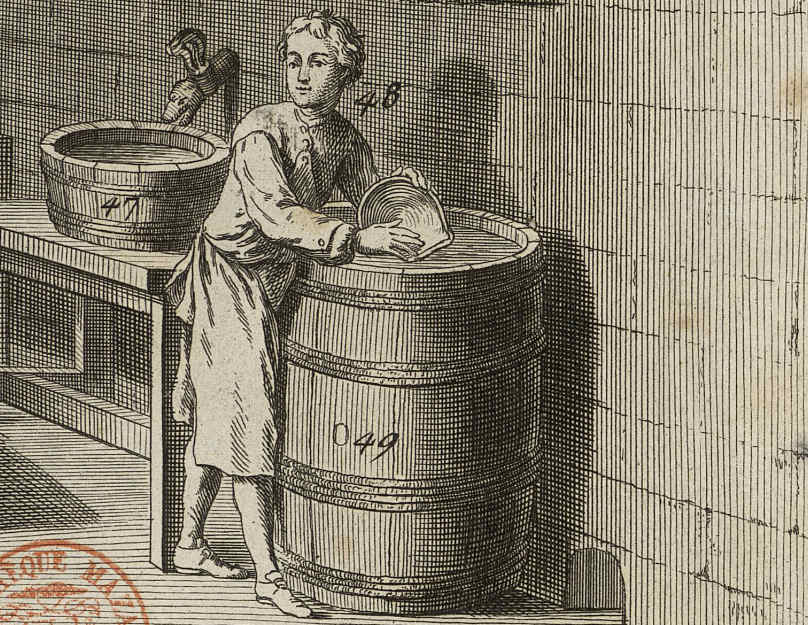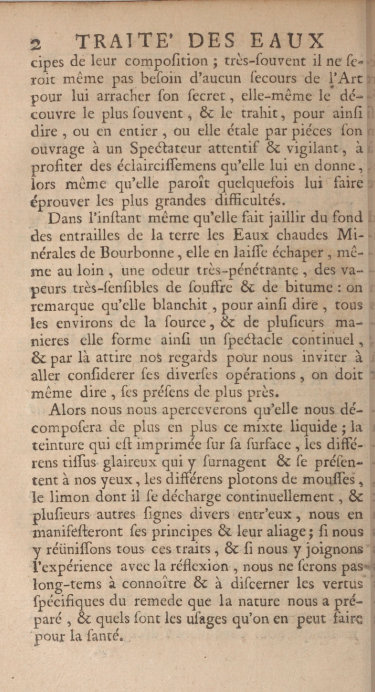—The role of sight, taste, smell, and touch in early modern chemistry.—
Understanding the role of the senses in the history of science poses unique challenges for the historian. Most sensory impressions are part of our daily experiences. Often, sensory impressions comes to us without the intervention of conscious thought. A smell in the air, the touch of an animal’s fur, the taste of a sour drink, these feelings make themselves known before we are able to put words on the sensation. Experience shapes the way in which we perceive sensory impressions, and sensory faculties evolve throughout one’s life. Because of the changeability of the senses, it can be difficult to view them historically. Those interested in the sensory experiences of the past can read written accounts, but we can not recreate the exact sensory impressions they experienced. Those difficulties have thankfully not discouraged research into the topic of the senses altogether.
The “Sensory Turn”, a movement spearheaded by Howes and Lalonde in the 1990s, has tackled this problem and offered compelling conclusions. Howes and Lalonde argued that the experience of the senses is context-dependant. For example, people living in a time where certain spices or fruits were an expensive rarity likely experienced some tastes more strongly than we would today. Several eighteenth century authors described the taste of the pineapple with strong superlatives, such as Hale whom in 1757 emphatically stated: “its delicious Taste absorb all other Merit”. Today, few would describe the humble fruit that many eat out of cans with such praise. This example suggests that understanding the relationship to the senses of a certain people at a certain time helps us better understand that time and those people.

Chemical dyes. Nicolas Hoizey, Unsplash.
Inspired by the methods of the Sensory Turn, I will turn here to the topic of eighteenth-century science, as scientific exploration relied on the senses in ways that are just as illuminating. I will present the case of French chemistry, and its relationship to the sensory, as a trusted tool used everyday by practicing chemists.
The texts which document the practice of eighteenth-century chemistry are numerous. Some chemists published their works in widely circulated books. Macquer’s Dictionnaire de Chymie (1773) or Lavoisier’s Traité élémentaire de chimie (1789) are two well-known examples of such texts. Others communicated by writing letters to one another or to scientific institutions, like the Academy of Sciences. The thoughts and impressions of chemists have also been recorded in their private laboratory notes. Using these different sources in combination gives a surprisingly clear picture of the use of the senses in chemistry.
A look at the sources of eighteenth-century chemistry shows that the relationship of chemists to the senses was not the same from one practitioner to the next, nor was it unchanging. The eighteenth-century was marked by changing attitudes towards the senses. Several philosophers wrote about the unreliability of the senses, viewing them as fickle and too changeable to be trusted. The French nobility, amidst brewing social tensions in the decades preceding the revolution, developed a stronger aversion to bad smells, as a way to create a sensory distance from the poorer population. But this negative view of the senses was not the consensus among those in the sciences, and the persistence of the senses in scientific writing is remarkable throughout the early modern period. Some chemists occasionally expressed doubt about the validity of their own senses in specific contexts. Some recounted having been misled by the taste of a substance, or the appearance of a stone, leading to a wrong conclusion. But in doing so, they demonstrated the ongoing use of the senses as part of laboratory practice, essentially treating the limitations of the senses in the same way as those of instruments, which could be equally deceiving when poorly used.
Chemists, much like other scientific practitioners, used the senses in their daily work, communicating their impressions using a precise vocabulary. Notably, they often did not work alone. They had assistants, they exchanged with colleagues, or with their family members. Frequent reports indicated that the chemist writing had asked for the opinion of their friends, their children, or perhaps the apothecary across the street, to gather second opinions on the taste or smell of a particular substance, which increased the reliability of sensory impressions.

Depiction of a laboratory assistant. Diderot and d’Alembert, Encyclopédie. vol planches III, planche 1 (1765). ENCCRE.
The senses were highly useful to the early modern chemist during experimentation. Taste was a staple technique in the identification of substances. Different salts could be immensely difficult to separate using instruments, but easy to identify by taste. Different qualifiers were used to describe taste. The feeling of certain products was described as “astringent”, “sharp” or “prickly”. Some salts tasted “burned”, “bitter”, or “crisp under the teeth”. Similarly, a number of different gases eluded instruments for a long time, but sulphur could be detected by scent by just about anyone. This smell was either described as that of “hatched egg”, or simply “sulphuric”. The senses were also useful when tracking the progress of ongoing experiments. A sudden puff of smoke, a change in scent, or the appearance of a coloured precipitate were all sensory cues that told the chemist that something had occurred. While easily set aside as trivial, these kinds of observations shaped the practice of chemistry.

Passage from a water analysis relying heavily on sensory description. M. Baudry, Traité des eaux minérales de Bourbonne les Bains, contenant une explication metodique sur tous leurs usages (Sirot, 1736), p. 2. Gallica.
The body and the senses were used in different ways by eighteenth-century chemists. The practice of chemistry relied on the careful execution of controlled gestures. Chemists needed steady hands, and they often had to watch their breath, their clothes, and their gestures so as to avoid burns or spills on the lab bench. Among the senses, sight was, for obvious reasons, most frequently used and mentioned in chemical reports. But taste was often used by analysts too. This was particularly true when they studied consumable products. A water could be described as having a “pleasant taste” or a “disagreeable staleness”, milks had a “soft and sweet flavour” but could turn “as strong as vinegar”. Scents often made themselves known in the laboratory, and they were therefore used as clues to the nature of certain products. Touch and textures was also useful to chemists. Often, they tried to break apart solids using their hands, gauging their nature by friability or ductility. Additionally, certain liquids, while identical in appearance, had a more oily texture when touched with the fingers — all important clues as to their chemical makeup.
With the ubiquitous place of the senses in chemical work, it stands to reason that chemists had to practice their own sensory abilities. They trained themselves to be able to identify subtle differences in tastes or smells. Chemistry courses, which became increasingly popular during the eighteenth century, were generally given on the basis of a lecture and demonstration format. But the more prestigious and paid courses allowed students to interact with the materials themselves, thus providing them with the opportunity to train their own gestures and senses. This kind of training was also a necessity, as much of chemistry practice involved working with deeply unpleasant sensorial experiences, for which new chemists had to learn to build a resistance. One chemist described a water which tasted so foul that it would repulse not only the average drinker, but also the practitioners who were supposedly accustomed to the “most ungracious flavours”.
The ubiquity of the senses in chemical work can be in part explained by chemists’ desire to make chemistry useful to society. Chemical texts frequently stressed many practical applications to society’s problems. Chemists also courted those in power, and made lofty promises towards improvements to industry, health, or agriculture. This kind of utility was often based in sensory qualities. For example, chemists wanting to improve health and safety in a variety of food products had to be able to distinguish what would be preferable tastes to the public. Chemists also worked to improve sanitation, and therefore sought chemical ways to neutralise smells. They also knew that while not all had access to instruments, most people had sensory knowledge. They therefore presented their findings in easily understandable terms, describing products which tasted like wine, spinach, or seawater, in order to be more relatable to a wider audience.

French Pharmacy of the 18th century, anonymous. Wellcome Collection.
It has often been argued that this tendency of chemists to work with the senses and to use them to communicate with their audiences constituted a relic of pre-modernity. Once chemistry became modern, in the aftermath of Lavoisier’s purported “Chemical Revolution” at the end of the eighteenth century, chemists gradually abandoned the senses in favour of more reliable methods, such as instruments and precise quantification. This is, however, largely inaccurate. This misconception is rooted in the assumption that it is impossible to be rigorous and sufficiently reliable when using the senses. Recent scholarship has put this into doubt. Work done by Fors, Anhfelt and Wendin has showed that a modern-day trained sensory panel was able to distinguish between substances using nothing but their senses, and to communicate their experience using language alone. They therefore argue that early modern chemists and apothecaries were able to infer a substance’s origin using their own senses, and to communicate their sensorial impressions effectively. This conclusion is supported by the rich variety of words, comparisons, metaphors, modifiers, and quantifying adjectives that early modern chemists had at their disposal, and which can be found everywhere throughout their writings, both public and personal.
Chemistry, both today and in the past, relied on the use of senses. But the attitudes towards the use of the body in science have changed over time. The eighteenth century is an important moment in the wider history of chemistry, which is often said to mark a turning point towards modernity. Because of this view, it is often thought that this period marked the end of sensory practices in the sciences. But the evolution of the use of senses throughout the eighteenth century is an important and often overlooked aspect of the development of the chemical discipline. Despite the rise of quantitative analytical methods, chemists continued to use their senses as it provided a crucial tool in the difficult endeavour of establishing trustworthy claims about chemical substances.
Armel Cornu
Uppsala Universitet / Université Paris Cité
How to cite this paper:
Cornu, Armel. Using the Senses in Science. Sabers en acció, 2024-01-24. https://sabersenaccio.iec.cat/en/using-the-senses-in-science/.
Find out more
You can find further information with the bibliography and available resources.
Recommended reading
Ahnfelt, Nils-Otto, Hjalmar Fors, and Karin Wendin. Historical Continuity or Different Sensory Worlds? What we Can Learn about the Sensory Characteristics of Early Modern Pharmaceuticals by Taking Them to a Trained Sensory Panel. Wissenschaftsgesch 43 (2020): 412–429.
Corbin, Alain. The Foul and the Fragrant: Odor and the French Social Imagination. Cambridge, MA: Harvard University Press, 1986.
Howes, David, and Marc Lalonde. The history of sensibilities: of the standard of taste in mid-eighteenth century England and the circulation of smells in post-revolutionary France. Dialectical Anthropology 16, no. 2 (1991): 125–135.
Spence, Charles. Are pineapples really delicious? The history of the pineapple’s taste/flavour and the role of varietal and terroir. International Journal of Gastronomy and Food Science 31 (2023): 1–11.
Studies
Berenstein, Nadia. Flavor Added: The Sciences Of Flavor And The Industrialization Of Taste In America. PhD diss., University of Pennsylvania, 2018. ProQuest (10749820).
Mandelkern, India Aurora. The Politics of the Palate: Taste and Knowledge in Early Modern England. PhD diss., University of California, Berkeley, 2015. ProQuest (3720659).
Palmer, Richard. In bad odour: smell and its significance in medicine from antiquity to the seventeenth century. In Medicine and the five senses, edited by William F. Bynum and Roy Porter. Cambridge University Press, 1993.
Smith, Pamela H. From Lived Experience to the Written Word: Reconstructing Practical Knowledge in the Early Modern World. Chicago, IL: University of Chicago Press, 2022.
Vanacker, Beatrijs, Lieke van Deinsen, and Inger Leemans, eds. Taste and Smell in the Eighteenth Century. De Achttiende Eeuw, 48. Hilversum: Verloren, 2017.
Sources
Fourcroy and Delaporte. Analyse chimique de l’eau sulfureuse d’Enghien. Paris: Chez Cuchet, 1788.
Lavoisier. Traité élémentaire de chimie, présenté dans un ordre nouveau et d’après les découvertes modernes par M. Lavoisier. A Paris: chez Cuchet, 1789.
Le Cat. Traité des sens. Amsterdam: Chez J. Wetstein, 1744.
Machy. Examen physique et chimique d’une eau minérale trouvée chez M. de Calsabigi à Passy, comparée aux eaux du même côteau connues sous le nom des nouvelles eaux minérales de Mme Belami. 1756.
Macquer. Dictionnaire de chimie contenant la théorie et la pratique de cette science, son application à la physique, a l’histoire naturelle. A Paris: Chez Théophile Barrois, Libraire, Quai des Augustins, n ̊18, 1778.
Morveau, Lavoisier, Monge, Berthollet, Fourcroy, Dietrich, Hassenfratz, and Adet, eds. Annales de Chimie. 30 vols. A Paris: Chez Joseph de Bosse, 1789–1799.
Websites and other sources
Brinkhof, Tim. The foul and the fragrant: what did the past smell like? The Past (blog). Big Think. April 8, 2022. https://bigthink.com/the-past/smell-history-stench-fragrance/.
Green, John. Scratch ‘n’ Sniff Stickers and the Indianapolis 500. The Anthropocene Reviewed (podcast). May 2019. https://open.spotify.com/episode/2YAIftkwZ89Dh4O6Hr8GxX?si=b1616ab8f6d74b7f.
Kennedy, C. Rose. The Flavor Rundown: Natural vs. Artificial Flavors. Science in the News (blog). September 21, 2015. https://sitn.hms.harvard.edu/flash/2015/the-flavor-rundown-natural-vs-artificial-flavors/.
Kiechle, Melanie. The Smell Detectives. Distillations Magazine. June 20, 2011. https://www.sciencehistory.org/stories/magazine/the-smell-detectives/.
Meyer, Michael and Bob Kenworthy. Making Senses: How Biohackers Are Using Artificial Perceptions to Enhance Reality. Produced by Mariel Carr. Distillations Podcast, April 4, 2017. https://sciencehistory.org/stories/distillations-pod/making-senses/.
Reddit. Food seasonings. r/Askhistorians. Last Revised 2023. https://www.reddit.com/r/AskHistorians/wiki/dailylife/#wiki_food_seasonings.



